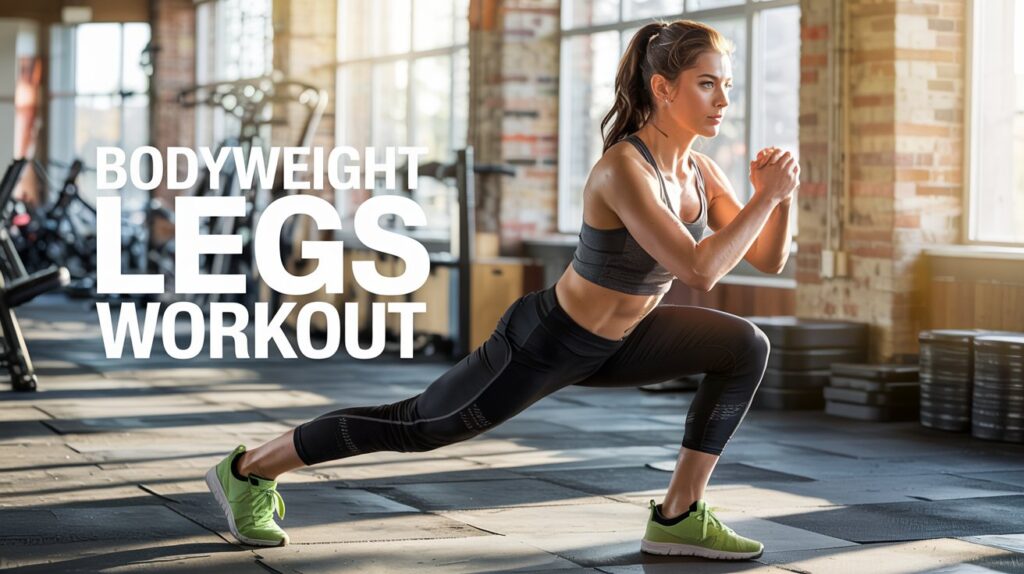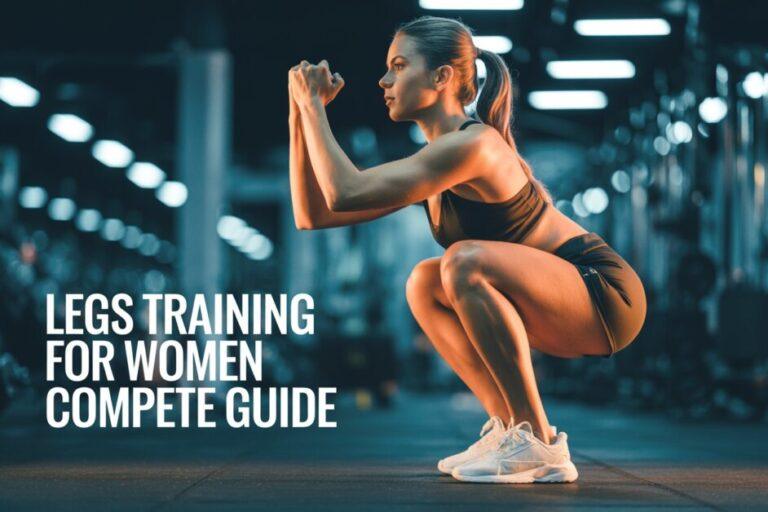Bodbyuilding a Foundation: Bodyweight Exercises for Leg Strength
Many individuals find themselves facing the challenge of weak legs, whether due to a sedentary lifestyle, injury, or simply a lack of targeted exercise. Addressing this weakness requires a strategic approach, and a solid foundation is best built through bodyweight exercises. These exercises offer a low-impact, accessible way to gradually increase strength and stability in the lower body, preparing the muscles and joints for more demanding activities later on.
The beauty of bodyweight training lies in its simplicity and adaptability. You don’t need expensive equipment or a gym membership to begin. Instead, you can utilize your own body weight as resistance, making it a convenient option for individuals of all fitness levels. Furthermore, bodyweight exercises can be easily modified to suit your current strength and range of motion, allowing for progressive overload as you get stronger.
Let’s break down the squat and expand on its benefits, proper form, variations, and considerations:
Beyond the Basics: The Squat – A Cornerstone of Lower Body Strength and Functional Fitness
The squat is far more than just an exercise; it’s a fundamental human movement and a cornerstone of lower body strength training. It’s a movement we use daily – sitting, standing, picking things up – and mastering it translates directly to improved functional fitness and overall well-being. As an exercise, the squat engages a vast network of muscles, making it a highly efficient and effective way to build strength and improve athletic performance.
Muscles Targeted: A Symphony of Strength
As mentioned, the squat is a powerhouse for lower body development. It recruits:
Quadriceps: These muscles on the front of the thigh are primary drivers of the squat, responsible for extending the knee.
Hamstrings: Located on the back of the thigh, the hamstrings work in conjunction with the quadriceps to control the descent and contribute to hip extension during the ascent.
Gluteus Maximus (Glutes): The largest muscle in the body, the glutes are essential for hip extension and stabilization throughout the movement. They play a crucial role in powering you back to the starting position.
Calves: These muscles in the lower leg assist in ankle stabilization and contribute to the push-off during the ascent.
Core Muscles: The core (including the abdominals and lower back muscles) acts as a stabilizer throughout the squat, maintaining a neutral spine and preventing injury. This often gets overlooked, but a strong core is critical for a safe and effective squat.
Adductors (Inner Thighs): These muscles assist in stabilizing the hips and knees, particularly during wider-stance variations.
Perfecting the Form: A Step-by-Step Guide to a Safe and Effective Squat
Achieving proper squat form is paramount to maximizing benefits and minimizing the risk of injury. Here’s a more detailed breakdown:
Starting Position: Stand with your feet shoulder-width apart, or slightly wider, with your toes pointed slightly outwards (about 5-15 degrees). This allows for better hip mobility and glute activation. Engage your core – imagine bracing for a punch to the stomach. Keep your chest up and your eyes focused forward or slightly upward.
The Descent: Initiate the movement by pushing your hips back as if you’re sitting down in a chair. Maintain a straight back, avoiding rounding or arching your spine. Keep your weight balanced over your entire foot, but focus on pushing through your heels.
Depth: Aim to lower your hips until your thighs are parallel to the ground. This is a good benchmark for most people. However, individual mobility and flexibility will dictate how low you can comfortably go. If you can’t reach parallel without compromising your form, it’s better to squat to a depth that feels safe and controlled. Over time, you can work on improving your mobility to achieve a deeper squat.
The Ascent: Drive through your heels, engaging your glutes and hamstrings to return to the starting position. Maintain a straight back and core engagement throughout the ascent. Avoid locking out your knees at the top, as this can put unnecessary stress on the joint. Squeeze your glutes at the top of the movement for maximum activation.
Breathing: Inhale as you descend into the squat and exhale as you return to the starting position. Proper breathing helps maintain core stability.
Squat Variations: Adapting the Squat to Your Needs
The basic squat is just the beginning. Numerous variations can be incorporated to target specific muscles, increase intensity, and challenge your body in new ways:
Goblet Squat: Holding a dumbbell or kettlebell in front of your chest adds a front load, which can improve posture and core stability.
Front Squat: Holding a barbell across the front of your shoulders (resting on your deltoids) places more emphasis on the quadriceps and upper back. This requires good mobility and core strength.
Overhead Squat: Holding a barbell overhead requires exceptional mobility, stability, and strength. It’s a challenging variation that works the entire body.
Sumo Squat: A wider stance with toes pointed outwards targets the inner thighs (adductors) and glutes more effectively.
Jump Squat: Adding a jump at the top of the squat introduces a plyometric element, increasing power and explosiveness. This is a great exercise for athletes looking to improve their jumping ability.
Bulgarian Split Squat: Placing one foot on a bench behind you increases the challenge to each leg individually, improving balance and stability.
Pistol Squat: A single-leg squat that requires exceptional balance, strength, and flexibility. It’s a challenging but rewarding exercise.
Box Squat: Squatting down to a box or bench helps maintain proper depth and can be useful for beginners or those recovering from injury.
Zercher Squat: Holding a barbell in the crooks of your elbows. This requires significant core strength and is a brutal variation.
Important Considerations and Modifications:
Mobility: Adequate ankle, hip, and thoracic spine mobility are crucial for performing a proper squat. If you lack mobility in these areas, you may need to incorporate mobility exercises into your routine.
Flexibility: Hamstring and hip flexor flexibility can also impact your squat depth. Stretching these muscles can improve your range of motion.
Knee Pain: If you experience knee pain during squats, consult with a physical therapist or healthcare professional. Incorrect form, muscle imbalances, or underlying conditions could be contributing factors.
Progressive Overload: To continue seeing results, gradually increase the weight you’re lifting, the number of repetitions you’re performing, or the difficulty of the squat variation.
Listen to Your Body: Pay attention to your body and avoid pushing yourself too hard, especially when starting out. Rest and recovery are essential for muscle growth and preventing injury.
Maximize the benefits:
To maximize the benefits of these exercises, consistency is key. Aim to perform these exercises several times a week, gradually increasing the number of repetitions and sets as you get stronger. Remember to listen to your body and avoid pushing yourself too hard, especially when starting out. Proper form is more important than the number of repetitions. In addition to these exercises, incorporating other bodyweight movements like glute bridges and hamstring curls can further enhance your leg strength and stability. By consistently engaging in these foundational exercises, you can effectively build a strong and resilient lower body, paving the way for more advanced training and improved overall physical function.
Ultimately, building leg strength requires consistency, patience, and a commitment to proper form. By gradually progressing from bodyweight exercises to weighted variations, and incorporating a variety of exercises that target all major muscle groups in the lower body, individuals can effectively overcome leg weakness and achieve a balanced and functional physique. Remember to listen to your body, prioritize proper form over lifting heavy weights, and seek guidance from a qualified fitness professional if needed.
Conclusion:
The squat is a versatile and highly effective exercise that offers numerous benefits, from building lower body strength and improving athletic performance to enhancing functional fitness and overall well-being. By mastering proper form, exploring different variations, and considering individual needs and limitations, you can unlock the full potential of this fundamental movement and enjoy a stronger, healthier, and more functional body. Remember to prioritize proper form over weight, and don’t be afraid to seek guidance from a qualified fitness professional.
The squat is a foundational leg exercise that works all major lower body muscles. Performed by lowering your hips as if sitting in a chair while keeping your back straight and core engaged, you aim to reach a thighs-parallel-to-the-ground depth and then push back up. Variations like sumo squats and jump squats offer additional benefits.
Another essential exercise is the lunge. Lunges are excellent for improving balance and coordination, while also strengthening the quadriceps, hamstrings, and glutes. To perform a lunge, step forward with one leg, lowering your body until both knees are bent at a 90-degree angle. Ensure that your front knee stays behind your toes and that your back knee doesn’t touch the ground. Push off with your front foot to return to the starting position and repeat on the other side. Variations like reverse lunges, lateral lunges, and walking lunges can further challenge your muscles and improve your overall leg strength.
Calf raises are often overlooked, but they are crucial for developing strong and stable ankles and calves. These muscles play a vital role in walking, running, and jumping. To perform a calf raise, stand with your feet flat on the ground. Slowly rise up onto your toes, squeezing your calf muscles at the top of the movement. Hold for a second or two, then slowly lower back down. You can perform calf raises on a flat surface or on a slightly elevated platform to increase the range of motion.
New Research: Creatine Boosts Memory by 31% & Processing Speed by 51%!
Glutamine – Ultimate Muscle Recovery & Gut Health
Carb Cycling to Burn Fat and Maintain Muscle – A Proven Strategy




